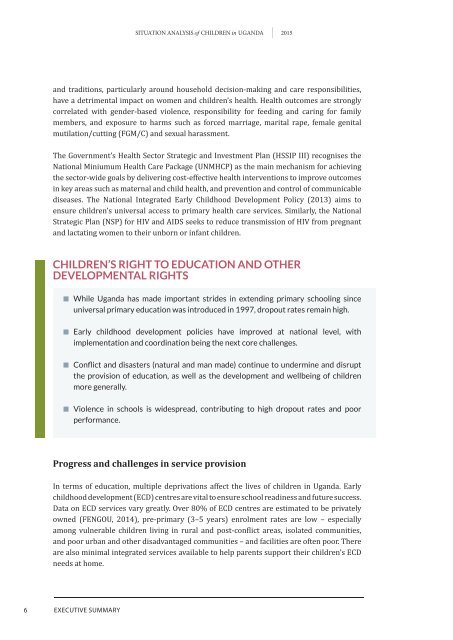Situation analySiS
1TNu802
1TNu802
Create successful ePaper yourself
Turn your PDF publications into a flip-book with our unique Google optimized e-Paper software.
<strong>Situation</strong> <strong>analySiS</strong> of Children in uganda 2015and traditions, particularly around household decision-making and care responsibilities,have a detrimental impact on women and children’s health. Health outcomes are stronglycorrelated with gender-based violence, responsibility for feeding and caring for familymembers, and exposure to harms such as forced marriage, marital rape, female genitalmutilation/cutting (FGM/C) and sexual harassment.The Government’s Health Sector Strategic and Investment Plan (HSSIP III) recognises theNational Miniumum Health Care Package (UNMHCP) as the main mechanism for achievingthe sector-wide goals by delivering cost-effective health interventions to improve outcomesin key areas such as maternal and child health, and prevention and control of communicablediseases. The National Integrated Early Childhood Development Policy (2013) aims toensure children’s universal access to primary health care services. Similarly, the NationalStrategic Plan (NSP) for HIV and AIDS seeks to reduce transmission of HIV from pregnantand lactating women to their unborn or infant children.CHILDREN’S RIGHT TO EDUCATION AND OTHERDEVELOPMENTAL RIGHTSwhile uganda has made important strides in extending primary schooling sinceuniversal primary education was introduced in 1997, dropout rates remain high.early childhood development policies have improved at national level, withimplementation and coordination being the next core challenges.Conflict and disasters (natural and man made) continue to undermine and disruptthe provision of education, as well as the development and wellbeing of childrenmore generally.violence in schools is widespread, contributing to high dropout rates and poorperformance.Progress and challenges in service provisionIn terms of education, multiple deprivations affect the lives of children in Uganda. Earlychildhood development (ECD) centres are vital to ensure school readiness and future success.Data on ECD services vary greatly. Over 80% of ECD centres are estimated to be privatelyowned (FENGOU, 2014), pre-primary (3–5 years) enrolment rates are low – especiallyamong vulnerable children living in rural and post-conflict areas, isolated communities,and poor urban and other disadvantaged communities – and facilities are often poor. Thereare also minimal integrated services available to help parents support their children’s ECDneeds at home.6 ExECUtIvE SUMMary




